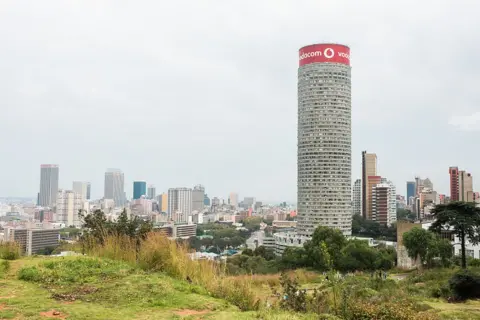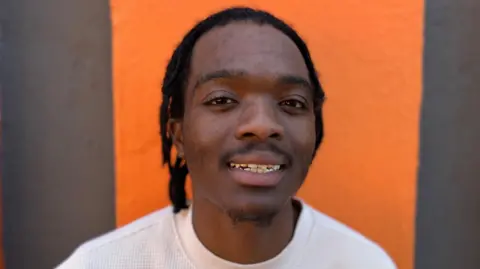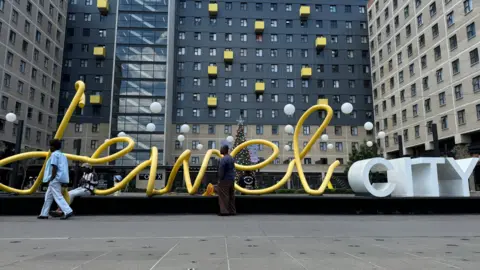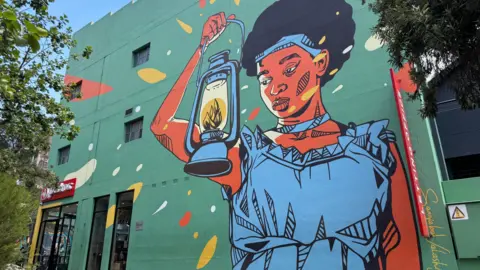Ed Habershon
BBC News, Johannesburg

 Getty Images
Getty Images
Ponte Tower is the tallest residential building in South Africa, and at one point became a hub of criminal activity
The view is spectacular from the top of Ponte Tower, one of the most famous buildings in the South African city of Johannesburg.
Built in 1975, standing almost 200m (656 ft) tall, it's a long-established feature of the city skyline, once the tallest residential building in Africa.
But like the city, it's had its ups and downs. In the 1980s it was taken over by criminal gangs, and its hollow core filled with rubbish up to 50m deep.
"The building got hijacked. There were no utilities, so most of the people were actually throwing their trash right inside the building, until it reached the 14th floor," said Delight Sithole, who runs tours of the building.
He added: "There were some dead bodies here, illegal firearms, drugs. The smell, I'm sure it was just horrible, just really like, hell on earth.
"If you asked anybody what happens in that round building, somebody would have something interesting or scary to say about it," said Sifiso Zikhali, who works with Mr Sithole in an organisation called Dlala Nje, which means "just play" in Zulu.
"People were scared of the neighbourhood," he said.
Johannesburg was seen as being one of the most dangerous cities in the world.
But the building turned itself around 15 years ago in the wake of the Fifa World Cup hosted in South Africa, and people started moving back in.
After Covid, people returned and the building is now around three-quarters full.
There is no escaping the issues that Johannesburg, and South Africa, face.
Despite signs of improvement in the most recent statistics, crime is still a major issue.

 Ed Habershon / BBC
Ed Habershon / BBC
Delight Sithole shows people around South Africa's largest residential tower, Ponte Tower
Crippling power cuts that plagued the city for years, known as load-shedding, came to an end almost a year ago, but now a water crisis is looming, leaving many without.
A building fire in the Central Business District (CBD) killed almost 80 people in the winter of 2023, and exposed the issue of hijacked buildings, disused housing and apartments blocks that have been taken over by criminal gangs who charge people to live there.
This is an area that's been regenerated by a property company called Ithemba, which is Zulu for "hope". And it's a company that is seeing business booming in Johannesburg.
A few days later, on a tour of one of Ithemba's flagship residential developments called Jewel City, senior manager Alan Tait explains the turnaround.
"The demand is just phenomenal, and that demand is specifically to live in the CBD," he said.
He said that the company currently leases 7,200 properties and is expected to double that over the next two years.
Named after its origins as a diamond dealing district, like the Ponte building the area fell into disrepair, only to see a resurgence.
"We launched Jewel City about five years ago, just as Covid was hitting. So the timing was a little bit out. But as soon as Covid lifted, the buildings filled up quite quickly," he said.

 Ed Habershon / BBC
Ed Habershon / BBC
Jewel City is one of the developments working to bring back hope to Joburg
As we near the edge of the development, he points out a long strip of lights under a flyover. They were put up to provide light in an area that had been dark for some time, largely due to the loadshedding affected the city.
It was part of an initiative by a group called JoziMyJozi which started in 2023. One of its first projects was to light up the Nelson Mandela bridge, a centrepiece of the city, that meant people once again found it safe to use.
"So the whole aim of JoziMyJozi is to bring hope back to the residents of the city," said Bea Swanepoel, CEO of the organisation, in the courtyard behind her office in Rosebank, north of the city centre.
"And by bringing hope back, we need to show some visible improvements and impactful projects so that they can see there's a way out of where we are currently, and to live in the city of the future, where people can be safe and where they can thrive and where there are jobs."

 Ed Habershon / BBC
Ed Habershon / BBC
This mural is an aspect of Ithemba's flagship residential developments called Jewel City
The group also launched the gateway project, an effort to clean up the ten main entrances to the city, and they've begun to tackle everything from potholes, to homelessness to education.
Could Johannesburg one day be spoken about like London, Paris or New York?
"Well, that is the intention," said Ms Swanepoel. "Much of what's happening in Joburg is due to perceptions. We have a long way to go. I mean, there's no doubt about that, but it's not impossible. We need to get up there and be the gold standard for cities in Africa."
The city is due to host the G20 later this year, which will bring new investment and attention to the city.
Back on 51st floor of the Ponte tower, Sifiso Zikhali gazes out of the window.
Does he think Dlala Nje is succeeding in its mission?
"Yes we are, because one of our biggest challenges was to get people coming here. We are now one of the city's top attractions. This is our city, and whatever we face, we need at the end to find a solution for it," he said.
You may also be interested in:

 Getty Images/BBC
Getty Images/BBC

 3 hours ago
3
3 hours ago
3









